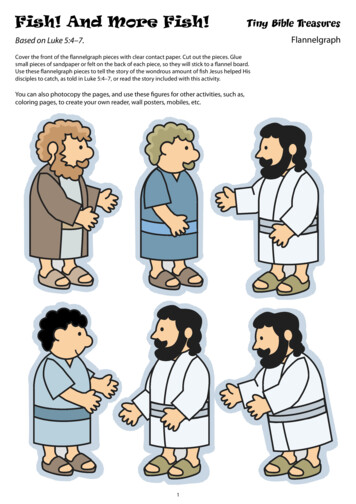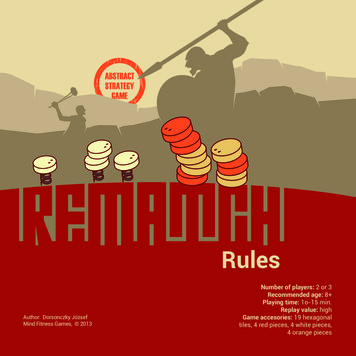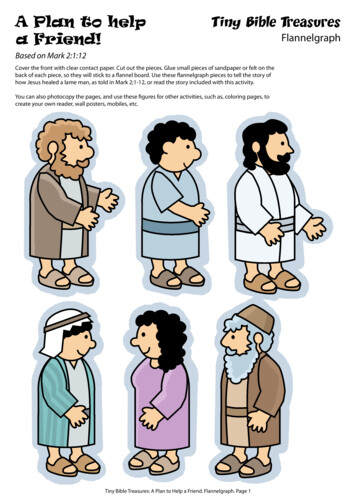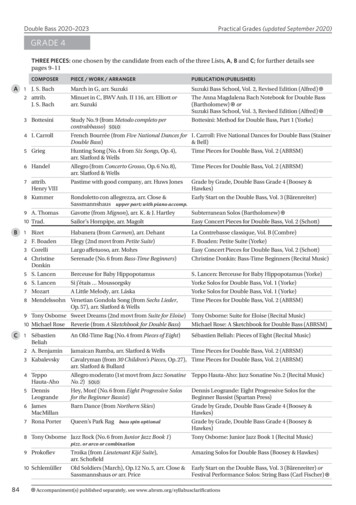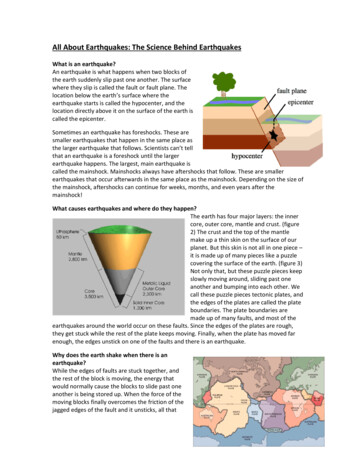
Transcription
10 Pieces of Evidence That ProveBlack People Sailed to the AmericasLong Before ColumbusPosted by Taylor GordonColumbus HimselfAccording to renowned American historian and linguist Leo Weiner of Harvard University, oneof the strongest pieces of evidence to support the fact that Black people sailed to America beforeChristopher Columbus was a journal entry from Columbus himself. In Weiner’s book, “Africaand the Discovery of America,” he explains that Columbus noted in his journal that the NativeAmericans confirmed “black skinned people had come from the south-east in boats, trading ingold-tipped spears.”
American Narcotics Discoveredin Egyptian MummiesThe discovery of American narcotics in Egyptian mummies has left some historians amazed.Recently, archaeologists discovered the presence of narcotics only known to be derived fromAmerican plants in ancient Egyptian mummies. These substances included South Americancocaine from Erythroxylon and nicotine from Nicotiana tabacum. German toxicologist SvetlaBalabanova reported the findings, which suggest that such compounds made their way to Africathrough trans-Atlantic trade that would predate Columbus’ arrival by thousands of years.
Egyptian Artifacts inNorth AmericaFor years, Eurocentric archaeologists have largely turned the other cheek when it came to thediscovery of artifacts from ancient Egypt being discovered in the Americas. According to Dr.David Imhotep, the author behind the book “The First Americans Were Africans: DocumentedEvidence,” “Egyptian artifacts found across North America from the Algonquin writings on theEast Coast to the artifacts and Egyptian place names in the Grand Canyon” are all signs of anearly arrival in the Americas by Africans. This is also paired with a much earlier account ofBlack people with incredible skills at sea. Back in 445 B.C., the Greek historian Herodotus wroteof King Ramses III leading a team of Africans at sea with astounding seafaring and navigationalskills. Together, both accounts would point to Africans sailing over to the New World beforeColumbus.
Ancient PyramidsConstructing pyramids was a highly specialized and complicated task that took the ancientEgyptians a lot of time to master. In ancient Egypt, there are signs of progression from theoriginal stepped pyramid of Djoser to the more sophisticated pyramids that now stand at Giza.According to historians, it would be impossible for any group of people to have built those samecomplex pyramids without going through the same progression. Professor Everett Borders notedthe presence of completed pyramids in La Venta in Mexico but the unusual absence of anyearlier forms of the pyramids. According to Borders, it’s a sign that Africans, having alreadymastered the construction of pyramids in Egypt, sailed over to the New World and constructedthese dual-purpose tombs and temples in the Americas.
Ancient African SkeletonsDiscovered in the New WorldThere have been many instances of archaeologists discovering skulls and skeletons that theybelieved clearly belonged to people of African descent. Polish professor Andrzej Wiercinskirevealed the discovery of African skulls at Olmec sites in Tlatilco, Cerro de las Mesas and MonteAlban. Even more ancient African skeletons that would clearly predate Columbus’ arrival in theAmericas were discovered throughout Central America and South America with some evenbeing unearthed in what is now California.
A Clear Link in ReligionThe similarities in Native American and African religions also suggest that Africans had to havehad early contact with the Native Americans by sailing to the New World. Before Columbusstumbled upon the Native Americans’ land, there were prominent figures of deities with darkskin and coarse hair throughout their religion. Today, many surviving portraits reveal thesedeities who were clearly crafted in the likeness of Africans. Historians also point to wallpaintings in caves in South America that depict the ancient Egyptian “opening of the mouth” andcross libation rituals.
The Accounts ofOther European ExplorersChristopher Columbus wasn’t the only European explorer who made note of an African presencein the Americas upon his arrival. Historians revealed that at least a dozen other explorers,including Vasco Nunez de Balboa, also made record of seeing “Negroes” when they reached theNew World. The accounts match up with the reports from the natives in Mexico. Nicholas Leon,an eminent Mexican authority, recorded the oral traditions of his people and ultimately kept trackof a key piece of evidence that Black people made it to the New World far before their Europeancounterparts. His reports revealed accounts from natives saying “the oldest inhabitants of Mexicowere blacks. [T]he existence of blacks and giants is commonly believed by nearly all the races ofour sail and in their various language they had words to designate them.”
Africans WereMaster ShipbuildersSome people insist that Africans couldn’t have made it to the New World first simply becausethey didn’t have the skill and resources to sail across the Atlantic. As it turns out, that’scompletely false. Historians have discovered evidence that suggests Africans were masters atbuilding ships and that it was actually a part of their tradition. Shipbuilding and sailing are over20,000 years old in the Sahara, and cave wall paintings of ancient ships were displayedin National Geographic magazine years ago. With those shipbuilding skills and the navigationskills that were noted by other historians of the time, the myth that Africans wouldn’t have beenable to sail to the New World becomes officially debunked. As Dr. Julian Whitewright, amaritime archaeologist at the University of Southampton, explained, the voyage from Africa onancient ships was “quite a plausible undertaking, based on the capabilities of the vessel of theperiod and historical material stating it took place.”
Gigantic Stone Headsin Central MexicoThe Olmec civilization was the first significant civilization in Mesoamerica and deemed “MotherCulture of Mexico” by some historians. This civilization dominated by Africans is best knownfor the colossal carved heads in Central Mexico that serve as even more evidence that Africanssailed to the New World before Columbus. The heads are clearly crafted in the likeness ofAfricans. The same civilization that created these giant heads was also responsible forintroducing written language, arts, sophisticated astronomy and mathematics to Mesoamericancivilization, ancient African historian Professor Van Sertima explained.
A Long History of Trade by SeaAccording to Paul Alfred Barton, the author of “A History of the African-Olmecs: BlackCivilizations of America from Prehistoric Times to the Present Era,” ancient kingdoms in WestAfrica have a long history of trade by sail, which made it all the more likely that they eventuallyexpanded their trade to the Americas. While the Sahara is a dry desert today, its past as a lakefilled, wet and fertile place has been well-documented. African ships often crossed these largelakes to get from place to place and traded with other African civilizations along the way. Afterexpanding their trade to the Americas, they certainly made their mark as things like Africannative cotton were soon being discovered all across North sailed-to-the-americas-long-beforecolumbus/
East Coast to the artifacts and Egyptian place names in the Grand Canyon" are all signs of an early arrival in the Americas by Africans. This is also paired with a much earlier account of Black people with incredible skills at sea. Back in 445 B.C., the Greek historian Herodotus wrote of King Ramses III leading a team of Africans at sea with astounding seafaring and navigational skills .


